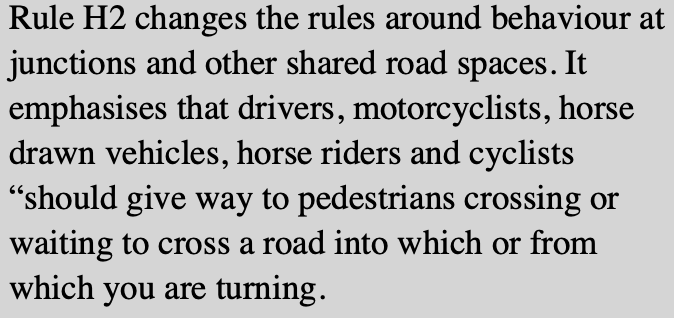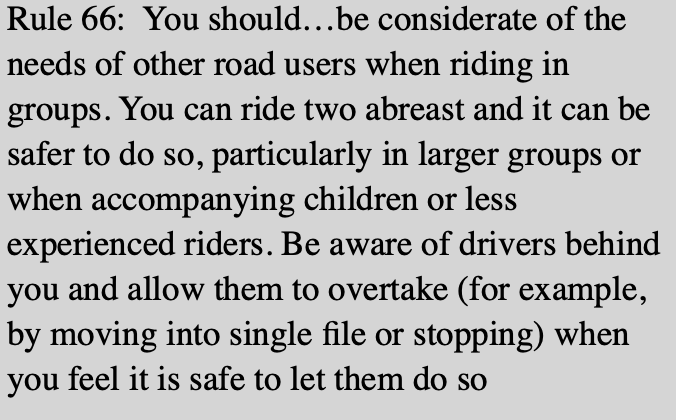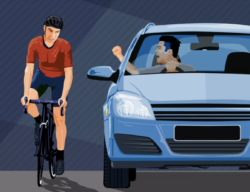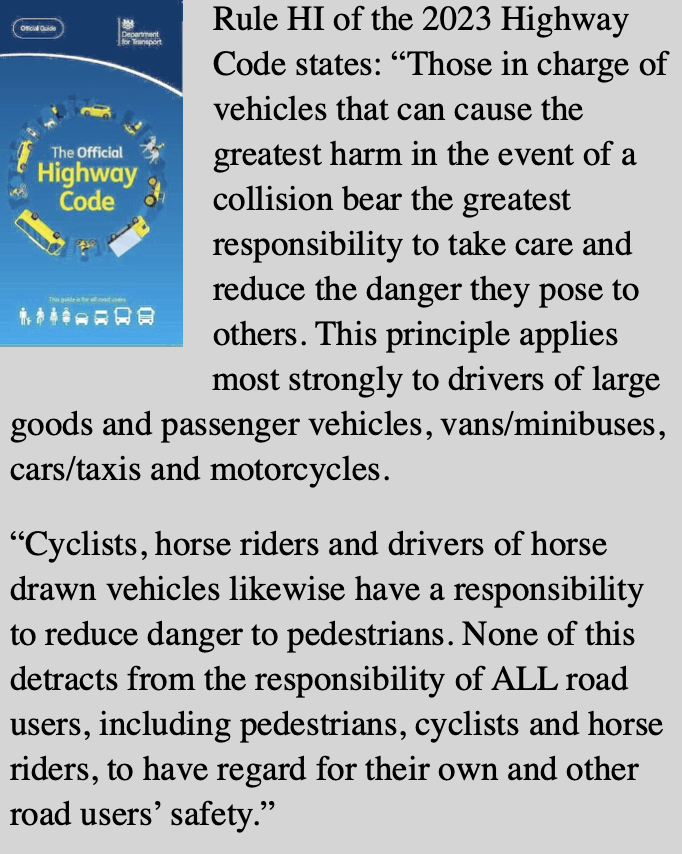 Abraham Lincoln
If given the truth, the people can be depended upon to meet any national crisis...
Abraham Lincoln
If given the truth, the people can be depended upon to meet any national crisis...
 Guildford news...
for Guildford people, brought to you by Guildford reporters - Guildford's own news service
Guildford news...
for Guildford people, brought to you by Guildford reporters - Guildford's own news service
Opinion: Conflict on the King’s Highway
Published on: 12 Feb, 2024
Updated on: 16 Feb, 2024
a personal view from chair of the London Road Action Group
The media (social, print and online) make frequent references to conflicts between motorists and cyclists, motorists and pedestrians, and cyclists and pedestrians. The Highway Code changes of January 2022 established a hierarchy of precedence in which the slower, most vulnerable travel space users were afforded priority.
If allegedly impartial reports are to be believed, there are still too many examples of the code proving ineffective, either because it is not being properly adhered to, not being adequately enforced, or generating frustration leading to bad behaviour.
- Motorists finding fault with cyclists for jumping red lights, or preventing smooth progress by unnecessarily riding two abreast, making overtaking difficult
- Cyclists complaining of drivers, of all kinds of motor vehicles, not allowing enough space when overtaking and being threatened by tailgating
- Pedestrians not receiving due consideration by turning motorists at junctions, as demanded by the Highway Code
- Pedestrians being intimidated by cyclists riding on pavements, which are not intended for shared use; intimidated around bus stops, whether within shared paths or where there is insufficient protection from immediately adjacent cycle tracks.
There even exists a conflicting dichotomy of interpretation of the hierarchy within the Highway Code. Motorists are expected to wait for a safe situation before passing a cyclist; there is no question of them demanding that a cyclist should “get out of the way and let me through” by sounding a horn. Yet cyclists are encouraged to alert pedestrians of their presence by sounding a bell or calling out, presumably expecting the pedestrians to make way for them.
 It seems that the ultimate solution to enhancing safety, for all space users, would be to ensure that each traveller category is not forced to share or be in close proximity to any other at any time.
It seems that the ultimate solution to enhancing safety, for all space users, would be to ensure that each traveller category is not forced to share or be in close proximity to any other at any time.
Enhancing safety by over-reliance on self-imposed human behaviour has not worked in any sphere of life; even increasing standards of regulation, with Draconian enforcement, would be highly improbable and wholly ineffective.
Given the existing way that highways have developed over the past two millennia in this country, there is just not enough publicly-owned space within many highways to achieve the above suggestion of complete separation. So, highway modifications that shun best practice and resort to the extensive use of “absolute minimum standards”, in an attempt to meet this impossibility, do not improve safety nor will they ever achieve “zero accidents”.
protect yourself at all times”
Such alterations of travel spaces may not even achieve marginally improved outcomes, because of the effects of human mistakes and misbehaviours. However, the interventions may have incurred an enormous level of expenditure and done nothing to reduce the earlier-mentioned frustration and hostility between users.
 Should the architects of these changes hold any responsibility for the inevitable event of subsequent accidents? Has the “glossy brochure” publicity been so persuasive that many users have had their expectations exaggerated, and their self-reliance undermined?
Should the architects of these changes hold any responsibility for the inevitable event of subsequent accidents? Has the “glossy brochure” publicity been so persuasive that many users have had their expectations exaggerated, and their self-reliance undermined?
Those who suggest and allocate sole or preferential right to the available space need to think long and hard about the effects of modifications, and whether they influence, for the better, the hostility and conflicts between users.
In the final balance, responsibility for self-protection when travelling by any mode has to remain with the individual, and whatever the travel space design and priority of allocation is, the only mantra must be: “protect yourself at all times”.
Responses to Opinion: Conflict on the King’s Highway
Leave a Comment Cancel reply
Please see our comments policy. All comments are moderated and may take time to appear. Full names, or at least initial and surname, must be given.Recent Articles
- Letter: I Would Rather Have Potholes Filled
- New Parish Councillor Says Funds from Developers Must Benefit the Local Community
- Tests at Paddling Pool Showed Water Was Too Alkaline, Says GBC
- Letter: Our Residents Want CIL Money Properly Used for Infrastructure Without Delay
- Charity’s New Programme Meets Needs of SEND Children Without School Places
- Pasta Evangelists to Open First Restaurant Outside London – Right Here in Guildford
- Police Seek Witnesses to Park Barn Assault
- Notice: Rosamund Community Garden
- Village School Set to Close Due to Falling Birth Rate
- Letter: Waverley’s Management of CIL Money Is Morally Questionable


Recent Comments
- Warren Gill on Millions of Taxpayer Money Recovered from Railway Fare Dodgers
- Roshan Bailey on Public Asked for Views on SCC’s Proposal for Reduced Speed Limits
- R Wong on Letter: Our Residents Want CIL Money Properly Used for Infrastructure Without Delay
- Nigel Keane on Village School Set to Close Due to Falling Birth Rate
- Patrick Bray on Public Asked for Views on SCC’s Proposal for Reduced Speed Limits
- Mark Percival on Public Asked for Views on SCC’s Proposal for Reduced Speed Limits
Search in Site
Media Gallery
Dragon Interview: Local Artist Leaves Her Mark At One of England’s Most Historic Buildings
January 21, 2023 / No Comment / Read MoreDragon Interview: Lib Dem Planning Chair: ‘Current Policy Doesn’t Work for Local People’
January 19, 2023 / No Comment / Read MoreA3 Tunnel in Guildford ‘Necessary’ for New Homes, Says Guildford’s MP
January 10, 2023 / No Comment / Read More‘Madness’ for London Road Scheme to Go Ahead Against ‘Huge Opposition’, Says SCC Leader
January 6, 2023 / No Comment / Read MoreCouncillor’s Son Starts Campaign for More Consultation on North Street Plan
December 30, 2022 / No Comment / Read MoreCounty Council Climbs Down Over London Road Works – Further ‘Engagement’ Period Announced
December 14, 2022 / No Comment / Read MoreDragon Interview: GBC Reaction to the Government’s Expected Decision to Relax Housing Targets
December 7, 2022 / No Comment / Read MoreHow Can Our Town Centre Businesses Recover? Watch the Shop Front Debate
May 18, 2020 / No Comment / Read More















Martin Giles
February 12, 2024 at 5:47 pm
Terry Newman tells us, in his thoughtful piece, to “protect ourselves at all times”, of course we should but we should protect others too. I regularly cycle, drive and walk in Guildford and witness bad, careless or inconsiderate behaviour from all types of highway users. What we really need is more awareness of the needs and safety of others and a little more patience (we all make mistakes at times).
I have seen cyclists inexcusably ignoring red lights or cycling without lights when dark.
When cycling, I have experienced drivers dangerously overtaking me whilst signalling to turn right and I have observed pedestrians completely unaware of my approach when looking at phones and/or with ear phones “plugged in”.
When walking I don’t feel confident that road users will give me pririty at road junctions.
Mr Newman says: “Motorists are expected to wait for a safe situation before passing a cyclist; there is no question of them demanding that a cyclist should “get out of the way and let me through” by sounding a horn. Yet cyclists are encouraged to alert pedestrians of their presence by sounding a bell or calling out, presumably expecting the pedestrians to make way for them.”
But when I sound my bell a more correct interpration would be “excuse me”, as I might say if I was a pedestrian requesting others to move to allow my progress.
The most frequent example of this for me is on the River Wey towpath. Pedestrians can, understandably walk two abreast, can be ambling slowly (why not?) and can be deep in conversation.
When I approach from behind a single “ting” of my bell normally causes them to move into single file to allow me to pass and I thank them, often provoking a “No problem,” or similar response; all very civil and considerate.
If pedestrians refuse to move aside, which I have experienced very occasionally, that is inconsiderate or if cyclists travel at reckless speed with no bell, or perhaps continuously ringing their bell and shouting “get out of my way” that is inconsiderate and dangerous.
The Highway Code cannot give perfect advice for every situation; we all need to take care for ourselves and for others. Most of us do, most of the time but that does not obviate the need for contiuous improvement to the design of our highways.
For me, one set of statistics needs to weigh heavily on those responsible: in 2022 (the most recent year for whiche stats are available), 91 cyclists were killed and over 15,000 injured in Great Britain, a very high proportion by collisions with motor vehicles. In the same year, 400 pedestrians were killed in collisions in the UK each year, less than three on average involve a bicycle. Mixing cyclists with pedestrians is far less dangerous than mixing bikes with motor vehicles.